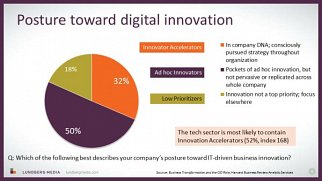Archive of: CIO
Blog Post

It is becoming increasingly common to hear CIOs say that any new applications their enterprises adopt should be cloud-based, with SaaS as the first option (will an existing service fill your needs?), and with custom-developed applications written to be cloud native. But what about the many legacy systems already running in your organization? After you've done an initial triage (see my previous post), large enterprises are left with significant portfolios of important and value-adding systems. According to a Computerworld interview with Stephen Orban, head of enterprise strategy at Amazon Web Services (AWS), "now that major enterprises have gotten their feet wet with smaller cloud projects, they're beginning to focus on migrating large, critical legacy workloads."
So here's my take on how to approach this.
Blog Post

Organizations often fall into new technologies haphazardly. Different groups discover new ways of working that better meet their needs, and they go for it. Eventually, CIOs find themselves with something of a jumble to manage.
Cloud is a particularly extreme example of this, as cloud services can be quite easy to sign onto. There are certainly categories of cloud services that CIOs don't need to control -- things that are opportunistic, department-specific and that don't need to link into core systems or data. As long as the acquiring business people understand and abide by some basic guidelines (mainly having to do with security), let a thousand flowers bloom.
However, when an organization starts to look to cloud for its enterprise IT needs, that's a very different story.
Blog Post

Software-defined everything is a hot topic these days -- first and foremost because the pace of change in business is accelerating, and this is changing expectations for how IT operates. I've been hosting a lot of CIO roundtables and dinners on this topic, and I hear a growing consensus that if IT organizations don't figure out how to compete with nimble cloud providers to provide IT services on-demand, they will be outsourced. "IT has to virtualize and automate or die," one IT leader said.
While many CIOs see a "service broker" role in their future, a VP of IT from a global technology manufacturer actually predicts the dissolution of IT altogether. He believes that all of the functions that are part of IT today will be pushed out into engineering, or product development, and all that will remain in IT is governance. A year ago, that statement would have been immediately shot down. Not today ...
Blog Post

The chief digital officer was the third most in-demand C-level position this year, according to executive search firm Korn Ferry. The rise of the chief digital officer (CDO) reflects the disruption being felt across industries from digital transformation and the impact this is having on organizations' business models. Well over half of respondents to a recent survey by Harvard Business Review Analytic Services say their organization's business model will be radically different in three years. These changes don't just happen; they need to be led.
Blog Post

I have to admit it — I'm baffled. In all the research I've done in the past year, business leaders again and again say they believe the CIO is the right person to lead digital innovation. And yet, again and again, there's a gap between where everyone — CIOs and their business partners included — think the CIO should be and where they actually are. CIOs just can't seem to break out of the technology service provider role.
In the Harvard Business Review Analytic Services study, "Business Transformation and the CIO Role," 94% of respondents said CIOs would add the most value to the business by either leading business technology transformation or, even better, leading IT-driven business innovation and strategy. Only 6% voted for the CIO to focus on running the IT function to support business operations. And yet the vast majority — 70% — said that's exactly where the CIO spends his or her time.
I've also had a number of conversations lately with strategic CIOs who view their role as helping their business leverage information — they frame the digital opportunity in that context. Sure, they need technology to do that, but that's not where the value lies or how they define their role.
Blog Post

Back in the 1990s and into the early part of the 2000s, we ran an awards program at CIO magazine called the Enterprise Value Awards. This was a unique and truly outstanding awards program that scrutinized the work being done by CIOs and their business partners — and the results being delivered — through the use of information technology. Every nomination had to have a CIO and a business leader as joint sponsors. They had to prove claimed financial value by having the company's CFO sign off on the numbers. Every finalist received a site visit from an experienced reviewer who met in person with company leaders and users of the system to vet the claims being made. These review board members then presented their findings to a blue-ribbon panel of CIOs at a day-long meeting in Boston. The winners were recognized at an annual Enterprise Value Retreat.
Blog Post

I just had my first highlights reel made and I'm pretty excited. I delivered the opening keynote at the Oracle Cloud World conference in Boston in December 2014. Oracle did a great job filming it in the first place, and my friend the very talented videographer Craig Kimberley at Skyprop Media did a great job editing it down to a couple of minutes. This shows both my onstage work and the kinds of (very visual) slides that I create. I hope you like it!
Blog Post

One of the most interesting research projects I've worked on in the past year was an HBR Analytics Services study sponsored by Red Hat as part of their Enterprisers Project. In it, we divided the universe based on respondents' posture toward IT-driven business innovation — for simplicity's sake, let's call it digital innovation. There were three categories:
Innovation Accelerators: These respondents said that digital innovation is a consciously pursued strategy throughout the organization — it's in their company's DNA.
Ad Hoc Innovators: These companies have pockets of digital innovation, but it is not pervasive or replicated across the whole company.
Low Prioritizers: At these firms, digital innovation is not a priority; they focus elsewhere.
Blog Post

I've saved the best for last in this series of posts on responsive IT. In our survey of 750 business and technology leaders (around 200 from IT and the remaining 550 from other parts of the business), 42% of respondents believe the CIO is the best suited member of the C-suite to lead digital transformation. (Yes, I know this term has become overused, but this is what we're talking about, so I'll learn to live with the shame.) That's more than twice as many as chose the CEO (18%). And that number shot up to 64% when we singled out the IT respondents. This is great news for CIOs, right?
Yes, but... when we look at the responses of general managers, things are less clearly defined. While CIOs still lead at 30%, there are also strong votes for the CEO (21%), LOB leader (17%), and COO (15%). This makes sense. As digital business becomes more pervasive, it is absolutely incumbent upon non-IT leaders to understand the opportunities and threats digital represents and to do everything in their power to drive their organization's ability to compete. Some of them are becoming quite astute in this regard. It's also true that even if the CIO is responsible on a day-to-day basis to lead this transformation, not much will happen without a clearly articulated vision from the CEO.
Blog Post

IT has become integral to many aspects of business, from marketing and customer engagement to new product design. This requires a new way of organizing and engaging across functions.
How important is this cross-functional engagement? It's huge. Seventy-five percent of the 750 respondents to our global survey (see “The Leadership Edge in Digital Transformation," from HBR Analytic Services) say that their company's survival depends on their ability to effectively exploit IT, and almost all — 90% — said that collaboration and communication between IT and other stakeholders in the business is essential to their ability to do so.




